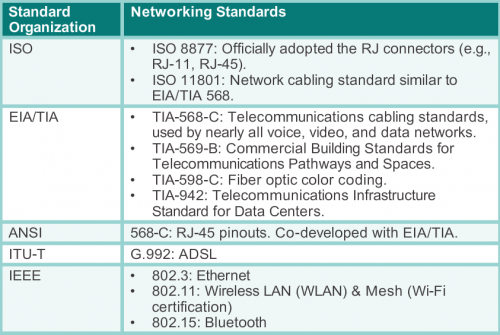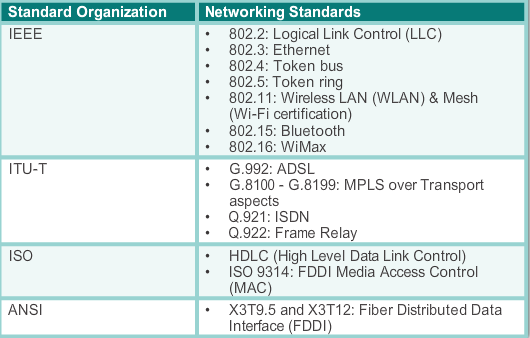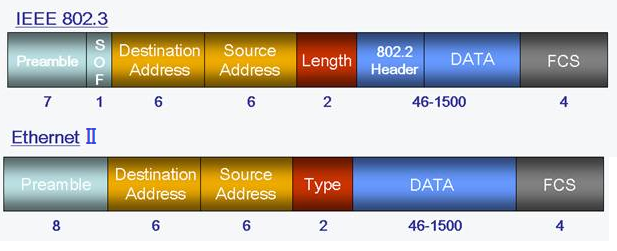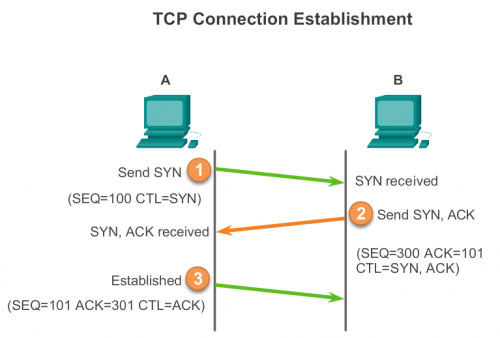Internet Standard organizations
Standards organizations include:
- The Internet Society (ISOC) is responsible for promoting open development, evolution, and Internet use throughout the world. ISOC facilitates the open development of standards and protocols for the technical infrastructure of the Internet, including the oversight of the Internet Architecture Board (IAB).
- The Internet Architecture Board (IAB) is responsible for the overall management and development of Internet standards. The IAB provides oversight of the architecture for protocols and procedures used by the Internet. The IAB consists of 13 members, including the chair of the Internet Engineering Task Force (IETF). IAB members serve as individuals and not representatives of any company, agency, or other organization.
- The Internet Engineering Task Force (IETF) mission is to develop, update, and maintain Internet and TCP/IP technologies. One of the key responsibilities of the IETF is to produce Request for Comments (RFC) documents, which are a memorandum describing protocols, processes, and technologies for the Internet. The IETF consists of working groups (WGs), the primary mechanism for developing IETF specifications and guidelines. WGs are short term, and after the objectives of the group are met, the WG is terminated.
- The Institute of Electrical and Electronics Engineers is a professional organization for those in the electrical engineering and electronics fields who are dedicated to advancing technological innovation and creating standards. The IEEE 802.3 and IEEE 802.11 standards are significant IEEE standards in computer networking. The IEEE 802.3 standard defines Media Access Control (MAC) for wired Ethernet. This technology is usually for LANs, but also has wide-area network (WAN) applications. The 802.11 standard defines a set of standards for implementing wireless local-area networks (WLANs). This standard defines the Open Systems Interconnection (OSI) physical and data link MAC for wireless communications.
- International Organization for Standardization (ISO), is the world’s largest developer of international standards for a wide variety of products and services. ISO is not an acronym for the organization’s name; rather the ISO term is based on the Greek word “isos”, meaning equal. It is known for its Open Systems Interconnection (OSI) reference model. ISO published the OSI reference model in 1984 to develop a layered framework for networking protocols. However, due to the rising popularity of the TCP/IP suite, developed by Robert Kahn, Vinton Cerf, and others, the OSI protocol suite was not chosen as the protocol suite for the Internet. Instead, the TCP/IP protocol suite was selected. The OSI protocol suite was implemented on telecommunications equipment and can still be found in legacy telecommunication networks.
- EIA - The Electronic Industries Alliance (EIA), previously known as the Electronics Industries Association, is an international standards and trade organization for electronics organizations. The EIA is best known for its standards related to electrical wiring, connectors, and the 19-inch racks used to mount networking equipment.
- TIA - The Telecommunications Industry Association (TIA) is responsible for developing communication standards in a variety of areas including radio equipment, cellular towers, Voice over IP (VoIP) devices, satellite communications, and more. Many of their standards are produced in collaboration with the EIA.
- ITU-T - The International Telecommunications Union-Telecommunication Standardization Sector (ITU-T) is one of the largest and oldest communication standard organizations. The ITU-T defines standards for video compression, Internet Protocol Television (IPTV), and broadband communications, such as a digital subscriber line (DSL). For example, when dialing another country, ITU country codes are used to make the connection.
- ICANN - The Internet Corporation for Assigned Names and Numbers (ICANN) is a non-profit organization based in the United States that coordinates IP address allocation, the management of domain names used by DNS, and the protocol identifiers or port numbers used by TCP and UDP protocols. ICANN creates policies and has overall responsibility for these assignments.
- IANA - The Internet Assigned Numbers Authority (IANA) is a department of ICANN responsible for overseeing and managing IP address allocation, domain name management, and protocol identifiers for ICANN
- the coordination of the assignment of technical protocol parameters including the management of the address and routing parameter area (ARPA) top-level domain
- the administration of certain responsibilities associated with Internet DNS root zone management such as generic (gTLD) and country code (ccTLD) Top-Level Domains
- the allocation of Internet numbering resources
Major L1 networking hardware standards
These standards are at physical layer 1 of OSI model.
Major L2 networking standards
These standards are at data link layer 2 of OSI model. These are unlikely defined by RFCs and are maintained by engineering and communication organizations.
Ethernet history
We have 2 Ethernet standards:
- IEEE 802.3 Ethernet standard which has been updated several times to include new technologies
- The DIX Ethernet standard which is now referred to Ethernet II
The differences between framing styles are minimal. The most significant difference between the two standards is the addition of a Start Frame Delimiter (SFD) and the change of the Type field to a Length field in the 802.3.
Ethernet II is the Ethernet frame format used in TCP/IP networks.
- 1973 - Ethernet - invented by Dr Robert Metcalf of Xerox corp
- 1980 - DIX standard called now Ethernet II - Digital Equipment Corp, INtel and Xerox (DIX) 10Mb/s Ethernet over coaxial cable
- 1983 - IEEE 802.3 10 BASE-5 - 10 Mb/s Ethernet over thick coaxial cable
- 1985 - IEEE 802.3a 10 BASE-2 - 10 Mb/s Ethernet over thin coaxial cable
- 1990 - IEEE 802.3i 10 BASE-T - 10 Mb/s Ethernet over twisted pair
- 1993 - IEEE 802.3j 10 BASE-F - 10 Mb/s Ethernet over fiber optic
- 1995 - IEEE 802.3u 100 BASE-xx - Fast Ethernet 100 Mb/s over twisted pair and fiber (various standards)
- 1998 - IEEE 802.3z 1000 BASE-X - Gigabit Ethernet over fiber optic
- 1999 - IEEE 802.3ab 1000 BASE-T - Gigabit Ethernet over twisted pair
- 2002 - IEEE 802.3ae 10G BASE-xx - 10 Gigabit Ethernet over fiber (various standards)
- 2006 - IEEE 802.3an 10G BASE T - Gigabit Ethernet over twisted pair
Ethernet 802.3 versus Ethernet II
802.3 (which uses 802.2 LLC format) has a Length field in the same place that Ethernet II has a Type field.
IEEE 802.3 with 802.2 LLC (used by Spanning-Tree, ISIS) use the highlighted bytes for a Length field. 802.3 Upper-layer protocols are decoded via the 802.2 LLC Header / SNAP bytes. The SNAP bytes are used to decode protocols using traditional ethertype values; SNAP is only included when the 802.2 LLC DSAP / SSAP = 0xAAAA.
+----+----+------+------+------+------+-----+
| DA | SA | Len | LLC | SNAP | Data | FCS |
+----+----+------+------+------+------+-----+
^^^^^^^^
DA Destination MAC Address (6 bytes)
SA Source MAC Address (6 bytes)
Len Length of Data field (2 bytes: <= 0x05DC or 1500 decimal) <---
LLC 802.2 LLC Header (3 bytes)
SNAP (5 bytes)
Data Protocol Data (46 - 1500 bytes) plus padding if required
FCS Frame Checksum (4 bytes)
Ethernet II - RFC 894 use these bytes for Type. Upper-layer protocols are decoded via the Type field
+----+----+------+------+-----+
| DA | SA | Type | Data | FCS |
+----+----+------+------+-----+
^^^^^^^^
DA Destination MAC Address (6 bytes)
SA Source MAC Address (6 bytes)
Type Protocol Type (2 bytes: >= 0x0600 or 1536 decimal) <---
Data Protocol Data (46 - 1500 bytes) plus padding if required
FCS Frame Checksum (4 bytes)
Generic view comparison
Ethernet frame sizes
Minimum frame size is 64 bytes and max is 1518 Bytes, not including a Preamble and Start Frame Delimiter. IEEE 802.3ac standard, released in 1998, extended the maximum allowable frame size to 1522 bytes by adding 4 Bytes of 802.1Q VLAN Tag field.
L3 Internet Protocol IPv4/IPv6
IPv4
Internet Datagram Header
0 1 2 3 0 1 2 3 4 5 6 7 8 9 0 1 2 3 4 5 6 7 8 9 0 1 2 3 4 5 6 7 8 9 0 1 +-+-+-+-+-+-+-+-+-+-+-+-+-+-+-+-+-+-+-+-+-+-+-+-+-+-+-+-+-+-+-+-+ |Version| IHL |Type of Service| Total Length | +-+-+-+-+-+-+-+-+-+-+-+-+-+-+-+-+-+-+-+-+-+-+-+-+-+-+-+-+-+-+-+-+ | Identification |Flags| Fragment Offset | +-+-+-+-+-+-+-+-+-+-+-+-+-+-+-+-+-+-+-+-+-+-+-+-+-+-+-+-+-+-+-+-+ | Time to Live | Protocol | Header Checksum | +-+-+-+-+-+-+-+-+-+-+-+-+-+-+-+-+-+-+-+-+-+-+-+-+-+-+-+-+-+-+-+-+ | Source Address | +-+-+-+-+-+-+-+-+-+-+-+-+-+-+-+-+-+-+-+-+-+-+-+-+-+-+-+-+-+-+-+-+ | Destination Address | +-+-+-+-+-+-+-+-+-+-+-+-+-+-+-+-+-+-+-+-+-+-+-+-+-+-+-+-+-+-+-+-+ | Options | Padding | +-+-+-+-+-+-+-+-+-+-+-+-+-+-+-+-+-+-+-+-+-+-+-+-+-+-+-+-+-+-+-+-+
The IP header structure is as follows:
4
|
8
|
16
|
32 bits
| ||||
| Total length | |||||||
| Fragment offset | |||||||
| Protocol | |||||||
IP header structure
| |||||||
The IPv4 header structure is as follows:
| Offsets | Octet | 0 | 1 | 2 | 3 | ||||||||||||||||||||||||||||
|---|---|---|---|---|---|---|---|---|---|---|---|---|---|---|---|---|---|---|---|---|---|---|---|---|---|---|---|---|---|---|---|---|---|
| Octet | Bit | 0 | 1 | 2 | 3 | 4 | 5 | 6 | 7 | 8 | 9 | 10 | 11 | 12 | 13 | 14 | 15 | 16 | 17 | 18 | 19 | 20 | 21 | 22 | 23 | 24 | 25 | 26 | 27 | 28 | 29 | 30 | 31 |
| 0 | 0 | Version | IHL | DSCP | ECN | Total Length | |||||||||||||||||||||||||||
| 4 | 32 | Identification | Flags | Fragment Offset | |||||||||||||||||||||||||||||
| 8 | 64 | Time To Live | Protocol | Header Checksum | |||||||||||||||||||||||||||||
| 12 | 96 | Source IP Address | |||||||||||||||||||||||||||||||
| 16 | 128 | Destination IP Address | |||||||||||||||||||||||||||||||
| 20 | 160 | Options (if IHL > 5) | |||||||||||||||||||||||||||||||
IPv6
4
|
4
|
16
|
24
|
32 bits
|
Source address (128 Bits) | ||||
Destination address (128 bits) | ||||
IPv6 header structure
| ||||
L4 TCP/UDP
TCP Transmission Control Protocol
Stateful, connection-orientated, reliable
The TCP header structure is as follows, IETF RFC 793 defined
16
|
32 bits
| |||||||
| Destination port | ||||||||
TCP header structure
| ||||||||
Control bits - 6 bits. The control bits may be (from right to left):
- U (URG) Urgent pointer field significant.
- A (ACK) Acknowledgment field significant.
- P (PSH) Push function.
- R (RST) Reset the connection.
- S (SYN) Synchronize sequence numbers.
- F (FIN) No more data from sender.
Window - 16 bits. The number of data octets which the sender of this segment is willing to accept, beginning with the octet indicated in the acknowledgment field.
UDP User Datagram Protocol
Best-effort transport protocol, stateless, connectionless, unreliable, No Flow Control, not connection-oriented
The UDP header structure is shown as follows, defined by IETF RFC 768
16
|
32 bits
|
Data | |
UDP header structure
| |



